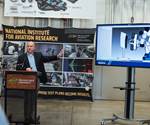NIAR begins construction on new ATL, AFP lab
The Advanced Laboratory for Aerospace System (ATLAS) will develop manufacturing protocols for automated fiber placement (AFP) and automated tape laying (ATL) for aircraft systems.
The National Institute for Aviation Research (NIAR) at Wichita State University (Wichita, Kan., U.S.) has begun construction on its new Advanced Laboratory for Aerospace Systems (ATLAS), which is located on the main campus headquarters and is expected to be completed in the summer of 2020.
ATLAS will be a facility for the development of manufacturing protocols for automated fiber placement (AFP) and automated tape laying (ATL) for aircraft systems incorporating real-time inspections and machine learning algorithms. NIAR senior research scientist Waruna Seneviratne will lead the lab.
Equipment and personnel within ATLAS will specialize in various areas: digital twin manufacturing technology development, rapid prototyping and manufacturing, machine learning, “Factory of the Future,” and cybersecurity and sabotage protection.
Two of the sectors for the lab are complete, two more are expected to be completed in the fall, with the rest expected to be completed in the summer 2020.
“ATLAS provides a neutral ground for manufacturers to research advanced manufacturing concepts with various machine, software and processing options,” says Seneviratne. “It will also educate and train student Factory of the Future engineers on advanced manufacturing concepts.”
NIAR also recently was awarded a $2 million grant to go toward research equipment for the ATLAS facility.
Related Content
-
Inside the MFFD — CW's coverage of the Clean Aviation multifunctional fuselage demonstrator
ÂÌñÏ×ÆÞ rounds up coverage of the MFFD project over the past decade. Now complete, the MFFD illustrates numerous processes and technologies for manufacturing primary aerospace structures using thermoplastic composites.
-
Airbus video highlights RACER compound helicopter first flight
Launched as part of a Clean Sky 2 program, a compound design — rotor, split fixed-wing, propulsive propellers — uses composites to cut fuel consumption and emissions by 20%.
-
Combining multifunctional thermoplastic composites, additive manufacturing for next-gen airframe structures
The DOMMINIO project combines AFP with 3D printed gyroid cores, embedded SHM sensors and smart materials for induction-driven disassembly of parts at end of life.
.jpg;width=70;height=70;mode=crop)





